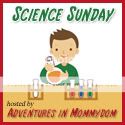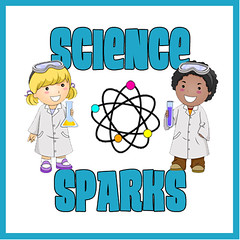Happy atoms have their rings completely filled with electrons. Some atoms share electrons with other atoms and some give away their electrons to form molecules. We demonstrated this by carrying shopping bags (representing the rings) around. Some bags could hold 2 electrons and some could hold eight. If they weren't completely full the shopper searched frantically until the bag was filled.
Once the kids understood that the atoms wanted full rings they began combining them to create molecules. Here is how they created a NH3, ammonia molecule.
Green gumdrops represented Nitrogen (N) atoms. Nitrogen contains seven electrons; 2 in the inner ring and 5 in the outer. To make Nitrogen happy, it wants three more electrons in its outer ring.
First the kids added three additional toothpicks in the gumdrop to be filled with electrons. Then they added a toothpick in a Hydrogen (H), red gumdrop, so it's inner ring could be filled with two electrons. Next, the Nitrogen an Hydrogen atoms were combined and they each shared an electron. Two additional Hydrogen atoms were needed to fill the outer shell of Nitrogen.
The result was NH3. We wrote down the chemical formula.
They played with the atoms and figured out that Oxygen (purple) could combine with two Hydrogen atoms. H2O.
and Carbon (orange) plus four Hydrogen atoms would create a molecule. CH4.
Well my daughter thought this was fun, but a bit too easy. Since she wanted a greater challenge, she combined atoms at will until they all had full outer shells. She ended up with C2H6N2O2 - Guess what? It's a real molecule called Methanamine.
After having so much fun they were surprised to learn the common names for the molecules they created.
H2O - Water
NH3 - Amonia
CH4 - Methane
Next several carbon atoms were linked together to create a carbon chain.
Sodium (Na) and Chlorine (Cl) were saved for the end. Instead of sharing electrons when they join, sodium gives chlorine an electron. The kids took a toothpick with an electron out of the sodium atoms and placed them into the chlorine atoms. The charged ions stick together because they are friends with opposite charges.
These are the NaCl molecules - table salt.
The kids thought this was a great activity and I was excited by how much they learned.
- Happy atoms have full outer rings
- Atoms share electrons or give away electrons to fill their outer rings
- Molecules can be written with chemical formulas
- The formulas tell what kind and how many atoms are in a molecule
- Chemical formulas such as H2O have more common names

This post was featured on:
Science Sparks
* I did not receive any compensation for this recommendation. I'm just a homeschooling mom who has found many products that I like. If you're interested in the products I recommend on this blog I want to make it easy for you to find them.
** I am an Amazon associate and receive a small portion of the sales on orders made after clicking in from this site, which I promptly spend on homeschooling books and supplies for my children.















My daughter would love this! Mostly because it involves marshmallows and gum drops. Looks like a fun educational activity.
ReplyDeleteHow cool and yummy:)
ReplyDeleteHere from the Hop.
I'm really enjoying all your science posts- especially the edible ones!
ReplyDeleteThis is an excellent idea. as soon as I get the marshmallows, we are all set.
ReplyDeleteThey form such beautiful creations, don't they?
ReplyDeleteHee hee, whenever I see marshmallow or gum drop creations with toothpicks, they always make me laugh. Probably because I know how little of the marshmallows would end up part of the project.......
ReplyDeleteThanks for linking up to Science Sunday!
I love these, they are on my list if things to make. :-)
ReplyDeleteThanks so much for linking to Science Sparks. xx